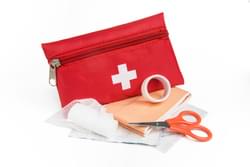




The following trail work safety tips should be covered with volunteers and crewmembers before the start of any trail work.

When doing trail work or maintenance, you should carry your typical outdoor recreation gear (the 10 essentials), along with some specialized trail building gear.
First Aid Kit
A standard first aid kit should contain the basic components to handle minor incidents (blisters, splinters, small cuts, etc.) that may occur during a workday. We also recommend carrying quikclot kits to help with more serious injuries until medical personnel can arrive.
Two-way Radio/Cell Phone
In remote backcountry areas, a two-way radio or cell phone can save you in case of emergency. Radios should be assigned to crew leaders as determined by the number of crews, remoteness of the work site, and accessibility to emergency facilities.
Emergency locator devices from companies like Garmin can also be useful in cases of emergencies when cell phones would not have service.
Gloves
Work gloves are necessary to grip tools as well as to protect the hands from blisters, thorny brush, poison oak or ivy, or any other minor scratches associated with trail work.
Safety Glasses
Safety glasses should be worn when using power tools, breaking rock, or anywhere flying debris is present.
Hard Hat
Protective headgear (hard hats) are used where there is a danger of falling debris from above the work area (tree canopy or falling rocks), or where one crew may be working above another, such as near a switchback.
Sturdy Footwear and Protective Clothing
Sturdy shoes or boots protect your feet from glancing tools and provide good footing when working. Thicker pants from brands like Carhartt are more durable and protect legs from flying debris, tools, and brush walking. Long sleeved shirts and hats protect against the sun.
Water and Food
All workers should carry adequate water supplies, and crew leaders should carry extra water. Workers should minimize or stop work if there is not an adequate supply of drinking water at the worksite.
Pack in your food for a full workday as well. You don’t want to be working while hungry.
Repair
No matter how well you care for a tool, it eventually will break. Typically you’ll notice the handle breaking well before the metal head on your striking and digging tools. If you notice the handle has cracked or has other significant damage, you’ll want to replace it before using the tool again.
Depending on the tool, replacing the handle can be as simple as unscrewing and replacing, or it may need a full shop, as is common with some fiberglass handles.
Many saws have blades that are easily replaceable when they snap, and having a replacement on hand is great for when that happens.
The metal head can have its cutting edge dull down, potentially making it dangerous to use. Examine tools regularly and plan on filing the edges when they are dull. If the head is cracked, replace the tool.
Sharpening
You get the best use from your tool when it is sharp. A 10 to 12 inch flat mill, or a flat, single-cut bastard file is the simplest tool for shaping a bevel or giving a blade an edge. Because of the tooth design, files cut in only the forward direction. Dragging on the backstroke will quickly dull the file. If the file becomes clogged with filings, clean it with a wire brush or a file card.
Safety Tip: Watch for the sharp edges once you're done! Make sure your file has a knuckle guard and handle. It’s also a good idea to wear gloves and safety goggles, especially if using a power tool to file.
posted Sep 11, 2023
The tools shown here are those used most often by Forest Service trail crews. They are categorized into tools for sawing, chopping, grubbing, digging and tamping, pounding, and hammering, lifting and hauling, peeling and shaping, and sharpening and rehandling. Each tool is described along with helpful techniques for use and maintenance.
Tools for Trails: Measuring and Surveying Tools
posted Nov 8, 2022
Before trail builders start digging, they first have to lay the trail, flag the line, and more to ensure a grade that not only matches the terrain but also is well throughout to prevent erosion.
posted Aug 8, 2022
Let’s talk about grubbing and raking tools! You might have heard the term grubbing before, but if you’re new to trail building, it may be unfamiliar. Grubbing is when you are removing earth and topsoil. Basically digging into the first while removing vegetation in the process. Trail builders may also call this process hogging.
posted Jun 8, 2022
There are a few options for striking tools that you may see out on a project. Some like the sledge hammer will be seen more, while others may only be pulled out for special projects.
3,348 views • posted 04/13/2018